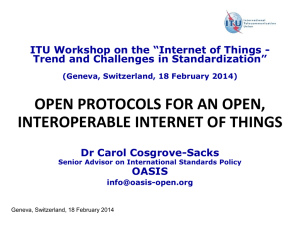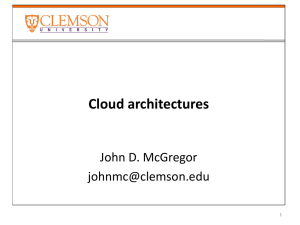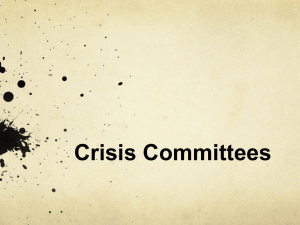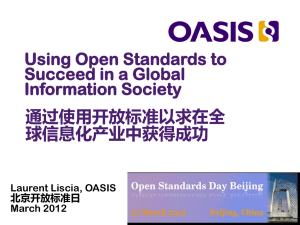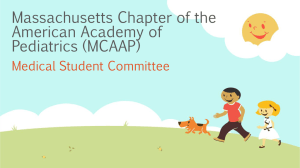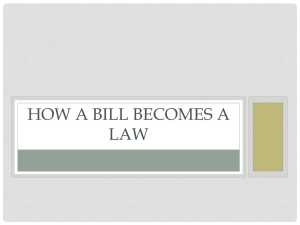Internet of Things
advertisement
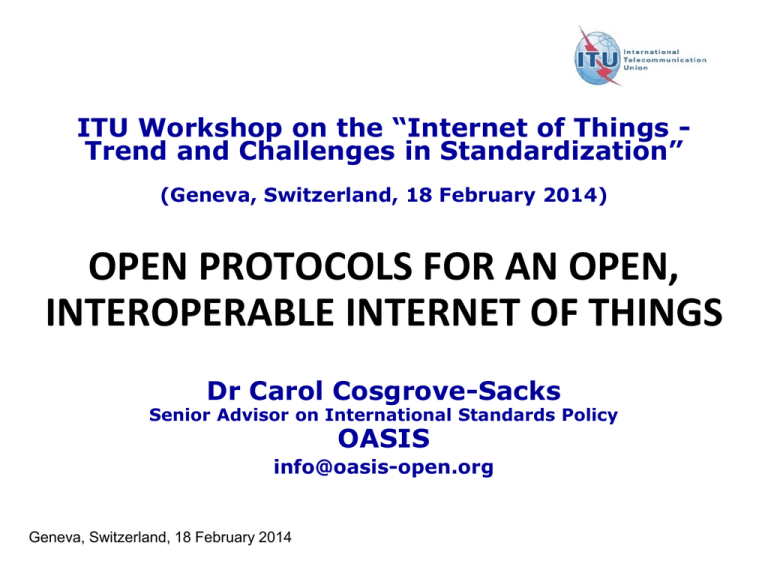
ITU Workshop on the “Internet of Things Trend and Challenges in Standardization” (Geneva, Switzerland, 18 February 2014) OPEN PROTOCOLS FOR AN OPEN, INTEROPERABLE INTERNET OF THINGS Dr Carol Cosgrove-Sacks Senior Advisor on International Standards Policy OASIS info@oasis-open.org Geneva, Switzerland, 18 February 2014 OPEN PROTOCOLS FOR AN OPEN INTEROPERABLE INTERNET OF THINGS • Open standards for the global info society • 5,000+ experts in 70+ tech committees What The Phrase Means Kevin Ashton coined "Internet of Things" phrase to describe a system where the Internet is connected to the physical world via ubiquitous sensors How Ubiquitous? Gartner: “IoT Installed Base Will Grow to 26 Billion Units By 2020.” That number might be too low. Every mobile Every auto Every door Every room Every part, on every parts list Every sensor in every device … in every bed, chair or bracelet ... in every home, office, building or hospital room … in every city and village ... on Earth ... The Challenges Every one of those sensor and control points is generating data. Often, it's very informative and very private data. Systems are needed to help those devices talk to each other, manage all that data, and enforce proper access control. Big Data means BIG Challenges All of the messaging, management, and access control technologies used in these large-scale device networks must be massively scalable. Open Protocols Current Internet and software methods are highly modular (APIs), highly distributed (Cloud) and "loosely coupled" (SOA). In today's systems, every LEGO brick comes from a different source – and they all still must snap together. This requires open, rapid and safe development methods. Open, Rapid and Safe: Open Source and Open Standards OPEN: Both work well. Easy to join, transparent to review. FAST: Open source methods work well. Rapid iterations and ease of contributions promote rapid development. (1) SAFE: Open standards methods work well. Strong IPR rules, balanced participation, neutral governance = usable work. (2) Fast open standards groups ... and solid open source projects ... work together very well Many open standards projects are robustly supported by free & open source software. Web standard (3) FOSS browsers (4) Identity standard (5) FOSS toolkits (6) Fast open standards groups ... and solid open source projects ... work together very well Giant ecologies can grow from open projects, promoting widespread use and adaptation. One open standard (UBL for e-invoicing) generates many local profiles, regional public projects and open source tools. (7) Fast open standards groups ... and solid open source projects ... work together very well Giant ecologies can grow from open projects, promoting widespread use and adaptation. This works in the Internet of Things as well. The OASIS MQTT TC (8) standardizes this industry protocol for lightweight sensor and device coordination, complemented and informed by Eclipse's open source implementation project. The two projects feed each other improvements. Key Challenges for an Open Internet of Things Lightweight protocols for devices to work together, communicate Unique and extensible identifiers for all those billions of devices Demand for API access and interoperability Cybersecurity Privacy and Policy Key STANDARDS emerging for an Open Internet of Things Lightweight protocols for devices to work together, communicate Unique and extensible identifiers for all those billions of devices OASIS MQTT, MQTT-SN (8) OASIS SmartGrid projects (9) Demand for API access and interoperability SOA/Cloud orchestration (11) and API standardization (AMQP, MQTT, OData) (12) Cybersecurity KMIP, SAML, XACML/JSON, PKCS11, CloudAuthZ (13) Privacy and Policy PMRM, PbDSE, and Personal Data Stores (14) Multiple new projects, XRI(10), UUIDs, etc. Open Standards and Open Source Projects will accelerate the development of the IoT Thank you! Questions? info@oasis-open.org Notes 1. FOSS: http://www.unctad.org/en/docs/c3em21d2_en.pdf (UNCTAD); http://www.netvibes.com/cabinetoffice#Open_Source (UK Action Plan). 2. Open Standards: http://www.wto.org/english/docs_e/legal_e/17-tbt_e.htm (WTO); http://www.talkstandards.com/standards-and-oss/. 3. HTML: http://www.w3.org/html/. 4. HTML FOSS Browsers: http://www.mozilla.org/en-US/firefox/new/ (Mozilla); http://www.w3.org/Amaya/ (Amaya). 5. SAML: https://www.oasis-open.org/committees/security. 6. SAML FOSS Toolkits: http://saml.xml.org/wiki/saml-open-source-implementations. Notes 7. UBL: https://www.oasis-open.org/committees/ubl (OASIS); http://www.nesubl.eu/ , http://en.wikipedia.org/wiki/OIOXML , http://www.peppol.eu/pilot-reporting , http://www.ibm.com/developerworks/library/x-ind-disrubl/ , http://www.opensourceacademy.eu/index.php?id=59 (guides); http://openinvoice.org/ubl4j/, http://sourceforge.net/projects/freeb-ubl , http://xmltools.oio.dk/oioonlinevalidator/ehandel/0p71/Invoice/ , http://www.ubl-italia.org/ubl-italia/imple/pgcl.asp?p=418, http://www.simpleubl.com/articles/what-is-nes/ (tools). 8. MQTT: https://www.oasis-open.org/committees/mqtt OASIS); http://wiki.eclipse.org/Paho (Eclipse); http://mqtt.org/news (industry). Notes 9. SmartGrid, Devices: https://www.oasis-open.org/committees/tc_cat.php?cat=smartgrid. 10. Identifiers: https://www.oasis-open.org/committees/xri (XRI); https://www.oasis-open.org/committees/xdi (XDI). 11. SOA and Cloud: https://www.oasis-open.org/committees/soa-rm (SOA); https://www.oasis-open.org/committees/tc_cat.php?cat=cloud (cloud computing). 12. API-oriented standards: https://www.oasis-open.org/committees/amqp (AMQP); https://www.oasis-open.org/committees/odata (OData); MQTT (fn 8). 13. Cybersecurity: https://www.oasis-open.org/committees/tc_cat.php?cat=security. 14. Privacy standards: https://www.oasis-open.org/committees/pmrm (Privacy Model); https://www.oasis-open.org/committees/pbd-se (Privacy by Design); https://www.oasis-open.org/committees/tc_cat.php?cat=privid (other).
